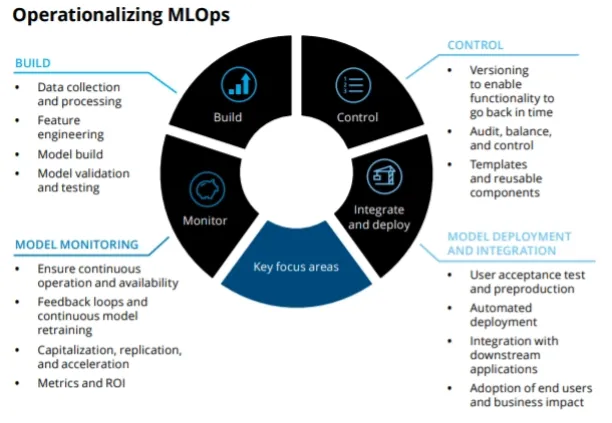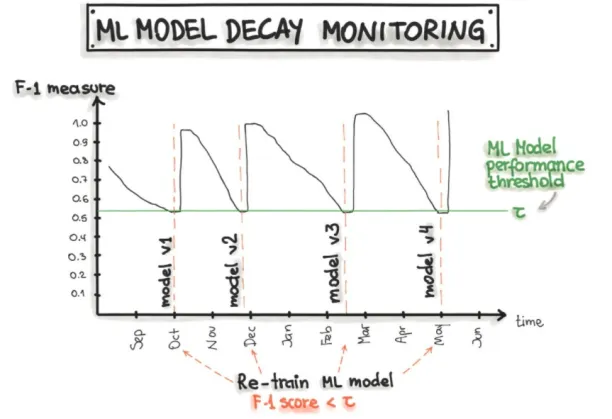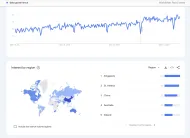Model Monitoring: Definition, Importance & Best Practices (2024)

As we pointed out in our article, Machine Learning Lifecycle MLOps systems have a lifecycle that includes various processes, and despite all the effort and time, creating an effective MLOps is not guaranteed. According to McKinsey, only 36% of companies can deploy MLOps. If the model deployment process is successful, the longest cycle in the life of a ML process, model monitoring, can begin.
What is model monitoring?

Model monitoring refers to the control and evaluation of the performance of an ML model to determine whether or not it is operating efficiently. When the ML model experiences some performance decay, appropriate maintenance actions should be taken to restore performance. You can think of the process as bringing your car in for maintenance from time to time and changing the vehicle’s tires or oil for better performance.
Why is model monitoring important?
Many companies make their strategic decisions based on ML applications. However, the performance of ML models degrades over time. This can lead to nonoptimal decisions for the company, which simply end up with performance degradation, profit or revenue declines, etc.
To prevent such a devastating effect, companies should consider the ML model’s performance threshold as a KPI that must always be met. Consequently, they should monitor their ML models regularly.
What are the reasons for ML model degradation over time?
Changing input data is the main reason why ML models degrade over time. Input data may change due to:
- The environment that ML predicts is constantly changing, so ML models should adapt to the new environment.
- Operating data in the pipeline may change over time.
Changing environment
ML algorithms predict the future or optimize processes based on data from the time in which the model is established. Consequently, the algorithms solve business problems according to the parameter values of that time interval. However, the environment we live in is constantly changing and so are the parameter values. Therefore, for effective interpretation of the data, the models must be updated according to the changes in the environment.
Let’s take the case of a chatbot, for example. We know that language is constantly changing. That is why it is difficult to understand Shakespearean English compared to today’s English. The words we use are also constantly changing. Some words we used a decade ago might be considered rude descriptors today. As a result, a chatbot designed a decade ago to maximize customer satisfaction could be giving customers unsafe times if left unmonitored.
Changing operational data
Time to time the operational data that is used in the pipeline might be changed. It is very common since the data engineering team has a limited control over where the input data comes from. The reason for that might occur due to dynamics of the business or new business decisions of the firm. Also, regulations might be the reason for such a change.
Let’s imagine a company in Hungary that sells imported goods from the USA. Today, Hungary uses the Hungarian forint as its national currency, which means that fluctuations in the forint compared to the U.S. dollar affect operational efficiency. However, a few years later, Hungary might use the Euro as its currency, which is subject to different fluctuations compared to the forint. Consequently, the upstream data should be adjusted accordingly.
What should companies monitor for healthy ML models?
In order to ensure effective working of ML models firms can check the following variables:
- Reality vs prediction check: compare the predictions of ML models with real world data. This is the best way to determine whether the model’s predictions are accurate or not. If there is a large gap between two, it means that the ML model needs to be systematically updated.
- Data distribution changes: As mentioned earlier, the world sometimes changes as fast as in the case of the Covid pandemic. Such circumstances lead to a huge shift in the data distribution. The shift in data distribution is a message for updating the ML model. Therefore, it is advisable to keep an eye on it.
- Error free data: ML models require high quality data to perform optimal analysis. Therefore, it is important to be sure whether the data is correct or not. Consequently, regular data cleaning can ensure the quality of the data.
- Fairness: If the ML model discriminates against one or more ethnic, religious, or other groups, it must be quickly serviced. This is because AI biases can have serious consequences for the company’s market value if they are uncovered.
- Operational Metrics: It is useful to check the usage of CPU, memory, hard disk and network I/O. If these are close to full capacity, maintenance is required for an effectively working ML model.
If you need assistant to find a MLOps developer, you can contact us:

Cem has been the principal analyst at AIMultiple since 2017. AIMultiple informs hundreds of thousands of businesses (as per similarWeb) including 60% of Fortune 500 every month.
Cem's work has been cited by leading global publications including Business Insider, Forbes, Washington Post, global firms like Deloitte, HPE, NGOs like World Economic Forum and supranational organizations like European Commission. You can see more reputable companies and media that referenced AIMultiple.
Throughout his career, Cem served as a tech consultant, tech buyer and tech entrepreneur. He advised businesses on their enterprise software, automation, cloud, AI / ML and other technology related decisions at McKinsey & Company and Altman Solon for more than a decade. He also published a McKinsey report on digitalization.
He led technology strategy and procurement of a telco while reporting to the CEO. He has also led commercial growth of deep tech company Hypatos that reached a 7 digit annual recurring revenue and a 9 digit valuation from 0 within 2 years. Cem's work in Hypatos was covered by leading technology publications like TechCrunch and Business Insider.
Cem regularly speaks at international technology conferences. He graduated from Bogazici University as a computer engineer and holds an MBA from Columbia Business School.
To stay up-to-date on B2B tech & accelerate your enterprise:
Follow on

Comments
Your email address will not be published. All fields are required.